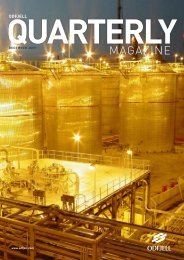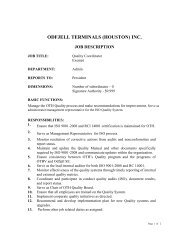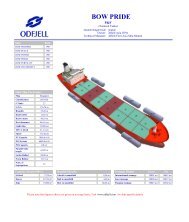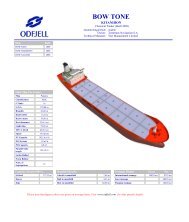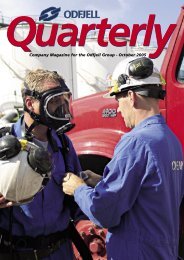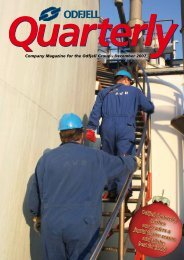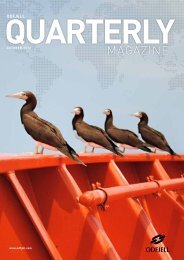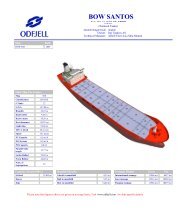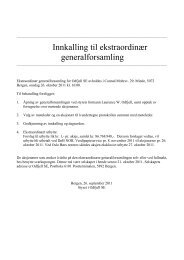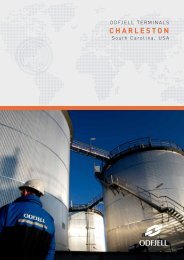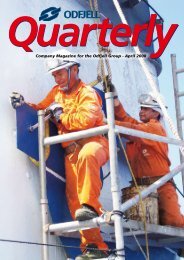You also want an ePaper? Increase the reach of your titles
YUMPU automatically turns print PDFs into web optimized ePapers that Google loves.
QHSE<br />
ODFJELL QUARTERLY magazine<br />
Making sustainable changes using Root Cause Analysis:<br />
–‘Smart’ problem solving<br />
By Bjørn Ydse<br />
Root Cause Analysis (RCA) is a process for<br />
identifying the ‘basic’ or ‘causal’ factors<br />
that underlies variations of outcome. RCA<br />
typically allows you to identify the “root”<br />
of the problem by questioning ‘how’, ‘why’<br />
and ‘where’ a problem, adverse event, or<br />
trend exists. This analysis should focus on a<br />
process that has the potential for redesign<br />
in order to reduce risk.<br />
Apollo Root<br />
Cause session<br />
for facilitators<br />
in Bergen<br />
RCA is also a way of looking at unexpected<br />
events and outcome to determine all of<br />
the underlying causes and identify recommended<br />
changes that are likely to improve<br />
them. Through RCA, you can make decisions<br />
and look for sustainable solutions based<br />
on data and facts. RCA focuses primarily<br />
on systems and processes, not individual<br />
performance.<br />
NR.04/ 11<br />
23<br />
Apollo in <strong>Odfjell</strong><br />
– a method for Root Cause Analysis<br />
Apollo RCA is a problem-solving method that<br />
is scalable depending on the significance of<br />
the problem and the ability of the RCA team<br />
to find not only the symptoms but also the<br />
causes. The method helps to “drill down” to<br />
the real causes and implement actions for<br />
the solutions. Apollo has been chosen as a<br />
company tool, and training of facilitators and<br />
managers has been carried out over the last<br />
half year at several locations worldwide. Some<br />
units have already used the method to find<br />
the real causes that have lead to incidents and<br />
more importantly have managed to identify<br />
preventive actions to avoid repetition.<br />
Where and when to use the method?<br />
All business units in <strong>Odfjell</strong> can use the<br />
method. Recent analyses and examples are<br />
from the ICT department in Bergen and an<br />
incident at the terminal in Rotterdam (OTR).<br />
Other typical examples can be related to:<br />
• recordable injuries<br />
• reportable releases /<br />
chemical spill to the environment<br />
• revenue - loss of profit<br />
• cost of non-quality for instance by<br />
re-work, off-hire, damaged product,<br />
lost customer<br />
• customer complaints<br />
• frequent incidents and ‘near misses’<br />
Return on investment<br />
Despite the impressive results that these types<br />
of analyses so often deliver, many companies<br />
fail to see the true potential of investing in<br />
RCA. The main reason for this is the perception<br />
that it’s too difficult, or even impossible<br />
to obtain the data needed. In addition, executives<br />
who are not close to the RCA process are<br />
likely to only see the expenses required such<br />
as employee training. Nevertheless, experiences<br />
from many companies worldwide show<br />
that it is fairly easy to see how RCA is able to<br />
help reduce cost. It is less obvious perhaps<br />
how RCA is able to generate revenue and<br />
profit margins. However, you only have to<br />
look at the fact that in most companies, the<br />
cost of non-quality is between 1.5 and 2.5%<br />
of the revenue. Therefore it should not be<br />
difficult to find reasons for investing and<br />
implementing in RCA methods to improve<br />
the costs of non-quality figures.<br />
odfjell quarterly magazine



